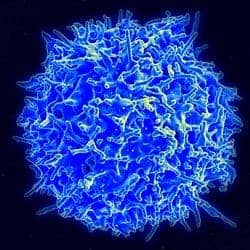Already known to cut proteins, the enzyme SPPL3 turns out to have additional talents, according to a new study from Johns Hopkins. In its newly discovered role, SPPL3 works without cutting proteins to activate T cells, the immune system’s foot soldiers. Because its structure is similar to that of presenilin enzymes, which have been implicated in Alzheimer’s disease, the researchers believe their findings could shed more light on presenilin functions, in addition to providing new insight into how the immune system is controlled.
A summary of their findings was published on Dec. 22, 2014 in the journal Molecular and Cellular Biology.
“No one could have predicted that SSPL3 was involved in T cell activation,” says Joel Pomerantz, Ph.D., an associate professor of biological chemistry at The Johns Hopkins University. “It walks like a duck and quacks like a duck, but its duck-like abilities don’t come into play here.”
T cells are immune system cells that kill invading cells and help activate other immune cells. When a foreign protein binds to a receptor protein on the outside of a T cell, a signal relay system is activated. It finishes when a protein called NFAT moves to the nucleus and turns on a number of genes to fully prepare the T cell for battle. Some of what happens in between is known, but Pomerantz and his team wanted to find more players in the process.
The researchers looked for proteins that could increase NFAT’s activity and found SPPL3, an enzyme that proved essential to NFAT’s activation but had never before been implicated in immune system function. Further tests properly placed SPPL3 within the sequence of events that lead to NFAT activation.
SPPL3 lives in the membrane of the endoplasmic reticulum (ER), a ruffled, membrane-bound compartment inside the cell that helps process new proteins, where it seems to encourage interactions between STIM1 and Orai1, two known components of the NFAT signal relay system. But SPPL3 turned out to accomplish this without using its enzymatic, or protein-cutting, abilities. It also encourages the release of calcium from the ER, which contributes to the signaling system, though it is unclear whether this is something it does directly or indirectly.
“SPPL3 is a relatively uncharacterized protein that had never before been implicated in immune system function,” says Pomerantz. “It opens up a whole new set of scientific questions.”
Pomerantz thinks that SPPL3 could be used as a drug target to either enhance the activation of T cells in immunodeficient individuals or to suppress it in those with overactive immune systems. He also plans to study the ability of SPPL3 to mediate the influx of calcium into the cell and the release of calcium from the ER, since calcium is integral to the functioning of many cell signaling networks.


